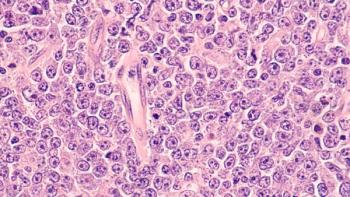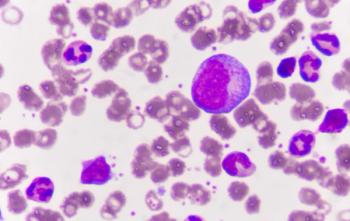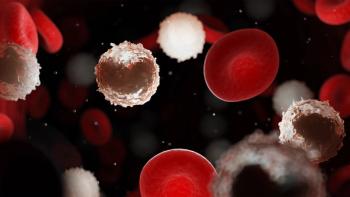
Frontline Zanubrutinib/Rituximab, Short-Course R-DHAOx Elicits Preliminary Results in Mantle Cell Lymphoma
Among 17 patients with mantle cell lymphoma, the complete remission rate with first-line treatment with zanubrutinib plus rituximab followed by short-course rituximab plus dexamethasone, high-dose cytarabine, and oxaliplatin was 88.2%.
Patients with mantle cell lymphoma (MCL) achieved encouraging preliminary results with frontline zanubrutinib (Brukinsa) plus rituximab (Rituxan), and consequent short-course rituximab plus dexamethasone, high-dose cytarabine, and oxaliplatin (R-DHAOx), according to preliminary results from the phase 2 CHESS trial (NCT04624958).1
Data presented in a poster at the 2022 ASH Annual Meeting revealed that at a median follow-up of 11.6 months (range, 1.93-20.03) and a median number of zanubrutinib/rituximab cycles of 4 (range, 2-7), patients experienced a complete remission (CR) rate of 88.2%. The best CR rate at any point during zanubrutinib/rituximab treatment was 94.1%. All 17 patients in the trial responded to therapy and all 4 patients older than 65 years achieved a CR.
At the time of the most recent follow-up in June 2022, 1 patient with blastoid MCL experienced progressive disease after a best response of partial remission. This patient had a progression-free survival (PFS) of 4.03 months.
“This approach might reduce the toxicity of cytarabine-based chemotherapy without weakening the therapeutic efficacy,” said lead study author Qing-Qing Cai, MD, a medical oncologist in the Department of Medical Oncology at Sun Yat-sen University Cancer Center in Guangzhou, China.
The next-generation, selective BTK inhibitor zanubrutinib has previously displayed activity in relapsed/refractory MCL. Additionally, combining a BTK inhibitor with rituximab has demonstrated efficacy and safety in the frontline setting of MCL in previous study results.
The ongoing CHESS trial is evaluating the efficacy and safety of zanubrutinib and rituximab followed by short-course R-DHAOx and maintenance zanubrutinib monotherapy.
The trial is enrolling previously untreated patients with MCL who were in need of immediate treatment. Once enrolled, patients are given induction therapy with 160 mg of oral zanubrutinib twice daily plus 375 mg/m2 of intravenous (IV) rituximab once every 4 weeks for up to 12 cycles or until patients achieve a CR, experience disease progression, or have unacceptable toxicity.2
Following a CR or the completion of 12 cycles of induction therapy, patients received R-DHAOx every 21 days for up to 4 cycles or until disease progression or unacceptable toxicity. R-DHAOx consists of 375mg/m2 of IV rituximab on day 1, 20 mg of IV dexamethasone on days 1 to 4, 2000mg/m2 of cytarabine on days 2 and 3, and 130mg/m2 of IV oxaliplatin on day 1. Notably, patients older than 65 years of age received a reduced dose of 1000mg/m2 of cytarabine. Patients who achieve a CR following chemotherapy will then be given maintenance zanubrutinib for up to 1 year at 160 mg twice daily.
Investigators are also collecting samples of bone marrow or peripheral blood to evaluate minimal residual disease (MRD) by flow cytometry at baseline and after every 2 cycles of treatment.
The primary end point of the trial is CR rate after induction therapy with zanubrutinib and rituximab. Secondary end points include objective response rate, overall survival, PFS, MRD, and adverse effects (AEs).
From October 2020 to April 2022, a total of 17 patients were enrolled in the study. The median age was 60 years (range, 26-70), and 82.4%of patients were males. The majority of patients had Ann Arbor stage III to IV disease (88.2%), classical subtype (88.2%), Ki-67 of at least 30% (52.9%), and bone marrow involvement (88.2%). Simplified MIPI score included low risk (47.1%), intermediate risk (47.1%), and high risk (5.8%).
Additional data showed the bone marrow–MRD negative CR rate was 88.2% (n = 15/17) after patients received zanubrutinib and rituximab. Among patients with evaluable for MRD in peripheral blood (n = 10), MRD detection was consistent with the bone marrow.
Investigators observed 1 instance of grade 3 or4 neutropenia and 2 instances of grade 3 or4 fatigue during treatment with zanubrutinib/rituximab. The most common grade 1 or2 AEs included rash (17.6%), neutropenia (17.6%), and subcutaneous hemorrhage (17.6%). Notably, no grade occurrences of grade 3 or4 atrial fabulation were reported. During treatment with chemotherapy, 76.9% of patients experienced grade 3 or4 thrombocytopenia.
Full efficacy, safety, and MRD data remain immature. Study authors said they are conducting further evaluation.
References
- Cai Q,Xia Y, Liu P, et al. Frontline Treatment with Zanubrutinib Plus Rituximab (ZR) Followed By Short Course R-Dhaox Shows Potent Efficacy in Patients with Mantle Cell Lymphoma (MCL) - Preliminary Results of Phase II CHESS Clinical Trial. Blood. 2022;140(suppl 1): 9356–9357. doi:10.1182/blood-2022-166237
- Zanubrutinib and rituximab followed by R-DHAOx then maintenance with zanubrutinib for newly diagnosed MCL. ClinicalTrials.gov. Updated May 9, 2022. Accessed January 4, 2023.
https://clinicaltrials.gov/ct2/show/NCT04624958
Newsletter
Knowledge is power. Don’t miss the most recent breakthroughs in cancer care.
















































































